Menu
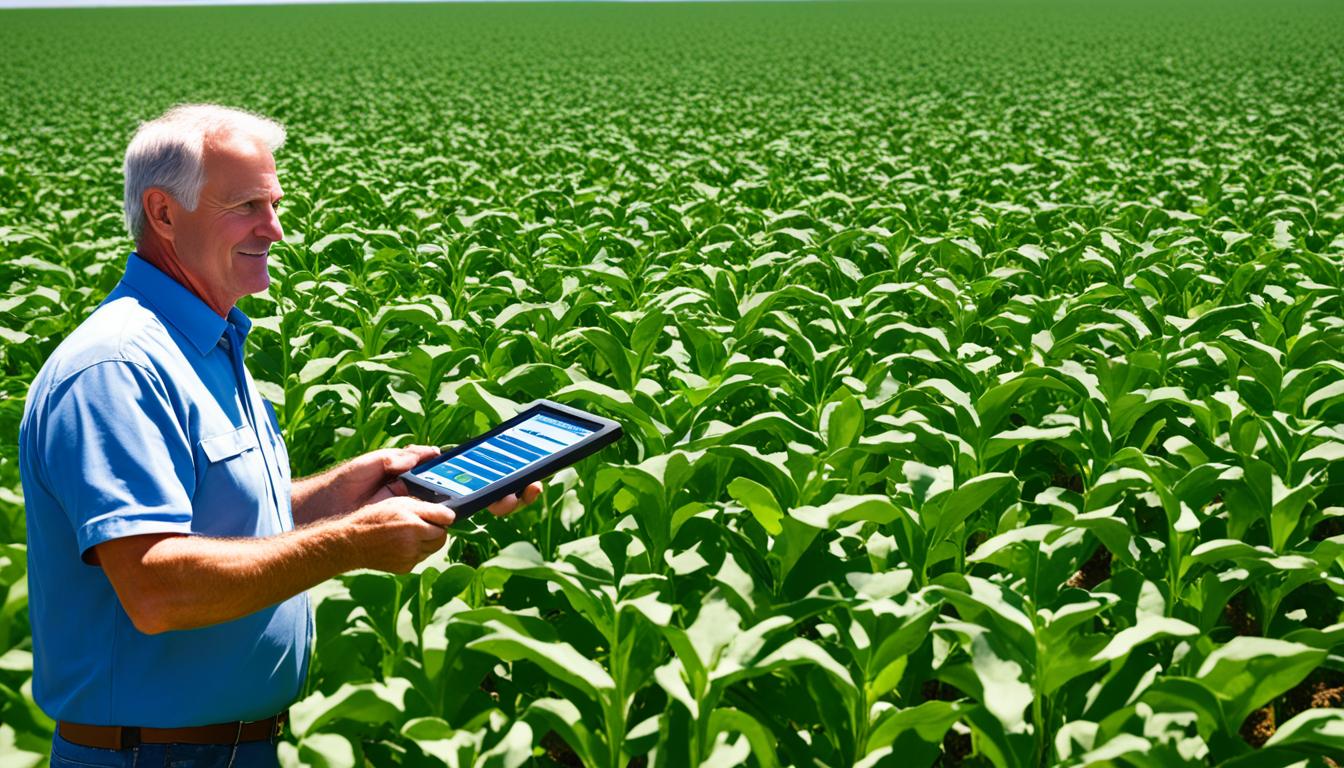
Did you know that precision agriculture helps farmers use less water and fertiliser? This saves a lot of resources. Precision agriculture is a modern farming method that uses technology to improve farming techniques.
It’s vital due to water shortages and unpredictable weather. It provides solutions using real-time data on soil and weather. Companies such as Trimble are leading by introducing automated systems. These systems control machines for managing pests and diseases, moving us towards an automated future.
The farming industry sees precision agriculture as a big step towards more sustainable and efficient farming. It’s becoming more popular worldwide. The goal is to use new, eco-friendly solutions from new companies. This approach not only enhances crop health and profit but also meets the demand for knowing where our food comes from.
In the late 1980s, a new farming method called precision agriculture began. It mixed grid-based soil sampling with equipment that controlled the amount of fertiliser used. GPS started working fully by 1993. This technological advancement allowed for detailed maps of crop yields. Soon, technologies for measuring soil and crop conditions, from the ground and the air, advanced.
This modern farming method uses specific technologies to farm more accurately and efficiently. It looks at the land, the weather, and what the plants need. Tools, services, and software work together to give information about the soil, plants, and the environment.
Since 1997, precision agriculture has been known worldwide. This was marked when the US Congress supported its development. Conferences, like the annual Australasian symposium, show how interest is global. Advances in satellite technology have made using equipment like auto-steering easier.
This farming method aims to increase farm efficiency and production while caring for the environment. It’s not just about crops; it also affects how we raise animals, fish, and manage forests. By using sensors, drones, and satellites, farmers can get real-time information. This helps them use resources better and make smart choices.
Here are some key points in the development of precision agriculture:
| Year | Milestone |
|---|---|
| Late 1980s | Emergence of precision agriculture aligning soil sampling and variable-rate applications. |
| 1993 | GPS full operationalisation leading to yield monitoring systems. |
| 1997 | Recognition of precision agriculture in the US Congress. |
| 1997-Present | Annual Australasian symposium on precision agriculture. |
| 1999 | Advances in GNSS technology facilitating machinery guidance and auto-steering. |
Looking at the future, precision agriculture will rely more on data from satellites and sensors. The goal is to optimise farm efficiency, quality, and environmental friendliness. This will be done in a farm-specific way.
In recent years, precision agriculture has seen big changes. Thanks to AI and IoT, it’s now more advanced. Back in the 1990s, farmers began using handheld devices to measure soil and boundaries. This was the start of precision farming.
AI plays a big role in making farming smarter. It helps in many ways, like predicting crop yields and running machinery. GIS shows detailed information about land. This helps farmers understand and manage their fields better. Machines and robots are also being used more. They make farming more efficient by cutting down on mistakes.
IoT is changing the farming game too. Sensors put in the fields collect real-time data on the soil and plants. They measure things like nutrients and moisture level. This data is super important for farmers doing precision farming. It helps them make better decisions. Thanks to stuff like satellite pictures, farmers can get quick updates on their fields’ health. IoT connects everything, making sure farms run smoothly and can be fixed right away.
Using big data has also become a big deal in farming. Looking at lots of data helps farmers know the best ways to grow crops. The precision agriculture market was worth 9.4 billion dollars in 2022. It’s expected to keep growing fast between 2023 and 2030. The use of new tech and data is making farming better and more efficient.
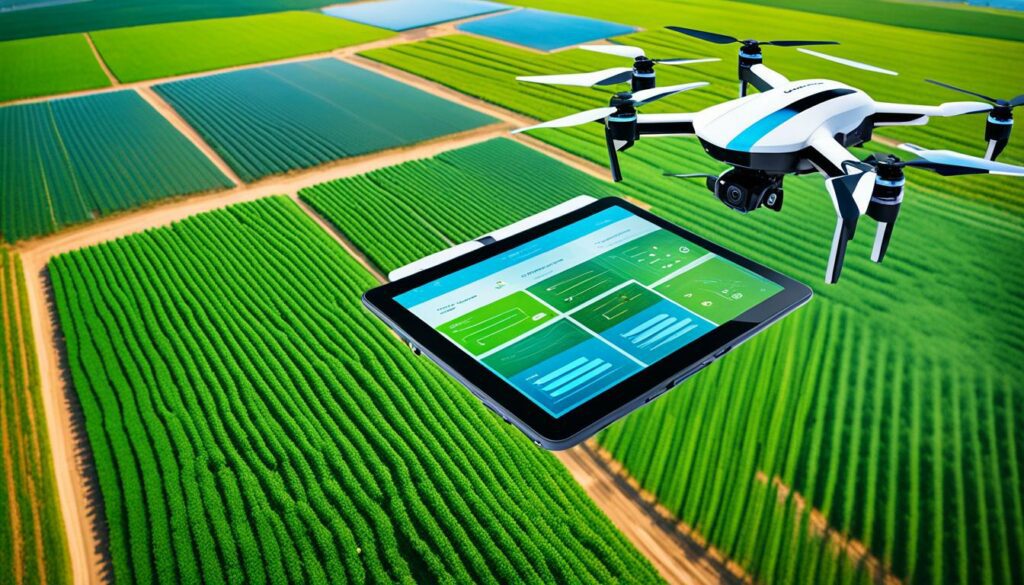
The future of farming is all about more AI and IoT. Soon, we’ll see more self-driving farm tools and farming methods just for one farm. Policy changes will also make farming more eco-friendly. Places like North America and Europe are leading in using these new technologies. But, other countries are starting to catch up too.
Yet, there are problems with getting more farms to use precision farming. It’s expensive to start. And, the tech can be hard to understand. Then there’s the issue of managing all the data. But, there are ways to fix this. Giving farmers money, simple tech, and training can help a lot. Good data management is also key. These steps are very important for making precision farming spread worldwide.
We can expect to see big changes in how we farm. These changes will make farming more efficient, more green, and produce more. Using lots of tech and data will make sure the future of farming is bright. AI, IoT, and digital solutions will play a big role in making this happen.
Precision agriculture changes farming by using tech to boost crop yields. It also helps use resources better and supports the environment. Just 27 percent of U.S. farms use these advanced methods. But, this shows there’s a big chance to grow. With about $200 million given for research and development from 2017 to 2021, the benefits are clearer than ever.
Precision agriculture helps get more crops by managing nutrients and planting carefully. With these tools, farmers have seen a 4% rise in crop yields. They can get the same or more crops using less. This boosts their profits and helps keep crops healthy.
Precision agriculture saves resources by using water and fertilisers better. It makes fertiliser use more efficient by 7%. It cuts down on herbicides and pesticides by 9%. It also uses 6% less fossil fuels. This not only saves money but also reduces waste. It makes farming both cheaper and greener.
Precision agriculture plays a big part in being eco-friendly. It stops runoffs and makes fields healthier. This cuts down the use of harmful chemicals and nutrients. If everyone used these methods, we’d use 48 million pounds less of chemicals. We’d also use 21% less water. With wider use, we could avoid a lot of CO2. This shows how important precision farming is for both farming and the planet.
Precision farming has many benefits. It helps crops grow more, saves resources, and protects the environment. Its impact on farming today is huge.
Precision agriculture has a huge potential. Yet, it faces several challenges that slow down its growth.
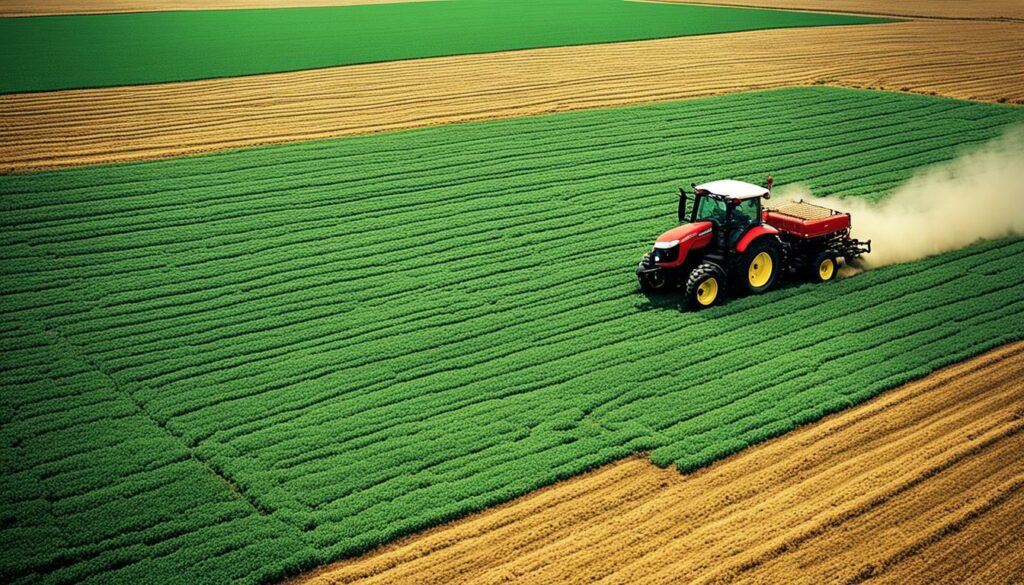
The main issue is the big money needed up front. To get started with precision farming, you need to buy high-tech gear. This includes stuff like GPS systems, drones, AI machines, and the software to run them.
Small farm owners often find these costs too high on their own. They struggle to invest without outside help.
The tools of precision farming produce a lot of data. This data comes from monitoring things like soil health, crop growth, and the weather. Wrangling this data management in agriculture is tricky. Yet, it’s key to making these technologies work well.
However, sorting and using this data is hard for many. Some farmers don’t have the means or knowledge to do it right.
The tech in precision farming can be pretty advanced. It requires skills with sensors, IoT devices, and special software.
This technical side might push some farmers away. Especially if they’re not into tech or don’t have the resources. Simplifying the technology and providing training is important for more people to adopt it.
| Challenge | Details |
|---|---|
| High Implementation Costs | Substantial initial investment for equipment and software; significant financial outlay |
| Data Management Issues | Need for efficient handling and interpretation of large data volumes; expertise and resource constraints |
| Technological Complexity | Advanced technology requiring significant knowledge and training; potential deterrence for non-technical farmers |
Overcoming these challenges in smart farming will take a varied approach. It includes helping farmers with money, simpler technology, and teaching them new skills.
Recently, precision farming has made great strides. It merges the latest tech with detailed data analysis to boost farming methods. This approach improves how farms run, cuts costs, and is kinder to the planet. Thanks to satellite tech and remote sensors, we now get real-time field updates. They show us the health of crops, the moisture in the soil, and how the fields are doing overall.
Satellite images and remote sensors are changing how farmers see and handle their lands. This tech gives live, close-up views of crops, helping farmers quickly spot and fix problems. Satellite maps, combined with GIS, also show the tiny details of the land. Before this, observing these details was hard.
At the heart of precision farming are soil and crop sensors. They keep sending data on nutrients, moisture, and soil health. This info lets farmers tweak their farming methods, ensuring the best conditions for their crops. These sensors are proof that mixing old farming ways with new tech can give great results.
Automated machines and farm robots are changing the game too. Self-driving tractors, automatic watering systems, and robot harvesters make farming more efficient and accurate. They lessen the need for people to work the fields. This tech paints a picture of a farming future that’s both more productive and eco-friendly.
AI is changing farming through smart use of data. It helps farmers predict the weather, diseases, and pests. This makes it possible to act before problems get out of hand.
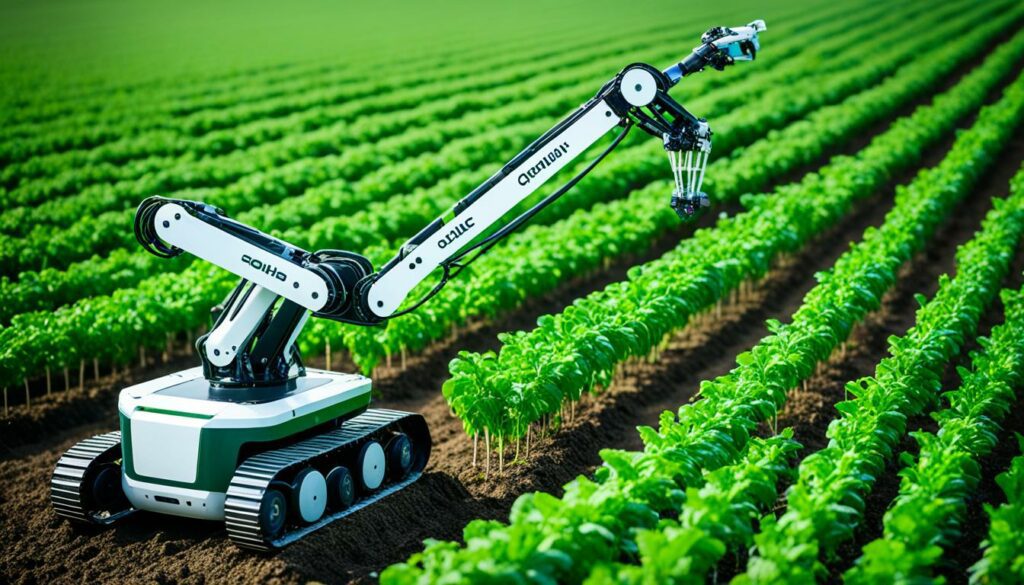
By 2050, the world will need to feed 10 billion people. AI, which is set to grow a lot, will play a big role in this. It helps farmers be more precise in applying pesticides and running their farms. For instance, CattleEye watches over cows, noticing when they give birth or behave strangely.
AI is also great at spotting diseases and pests in crops, with over 90% accuracy. This is key for keeping our food safe and plentiful. It lets farmers manage crops automatically, making sure they get just the right amount of water. This saves water and helps the environment.
| Advantages of AI in Agriculture | Statistics |
|---|---|
| Boosting Global Agriculture | Up to $1.5 trillion annually by 2030 |
| Reducing Production Costs | By 10-20% |
| Increasing Yields | By 10-15% |
| High Accuracy in Detection | Over 90% |
AI helps farmers work better by using data to predict how much crops will grow. It lets them know what the market needs and when to plant and harvest. This smart way of farming leads to better decision-making.
Using AI on the farm cuts down on the work people need to do. It combines smart farming tools with useful predictions. This is the start of a new, efficient, and planet-friendly way to meet the world’s growing need for more food.
IoT is changing farming by bringing real-time crop watching and better decision-making. It connects many tools and systems in farming, making work smoother and smarter. Through real-time tracking, it helps farmers deal with problems like bugs and diseases fast.
As we want better food and face climate change, we need smart solutions. IoT is stepping up in farming to make things work better and at the right time. Companies like FieldWise and Velos IoT are providing tools to check crops in real-time. These help farmers see their fields better and act quickly when problems come up.
Precision farming tools with IoT, like self-driving cars and smart sensors, make work more accurate. They help farmers not rely too much on the weather. More and more farms are choosing to use IoT devices, and this trend is growing fast. This is making the global smart farming market bigger, expected to triple by 2025.
Also, getting IoT to work in remote areas needs special technology. Places with poor internet can’t easily use IoT in farming. But, new tech is helping solve this issue. So, farmers in distant areas can join the smart farming movement too.
Modern agriculture relies on sustainable practices. Farmers use precision agriculture to use resources better and keep crop yields high. This includes using GPS for accurate planting and drones to limit pollution by controlling chemicals.
Focusing on water, farmers use precise irrigation to keep plants healthy without wasting water. Using the sun to power irrigation lessens the need for non-renewable energy. It saves water, lowers farming costs, and helps the environment.
Agriculture now plays a crucial role in fighting climate change by capturing carbon. This is done by improving soil and increasing plant growth. Listening to data, farmers make smart choices to get more results using less, helping both their farms and the planet.
Precision planting changes farming by using hi-tech methods to put seeds in just the right place. This makes sure seeds grow evenly and under the best conditions. By using tools like soil sensors and high-tech machines, farmers can plant with great accuracy.
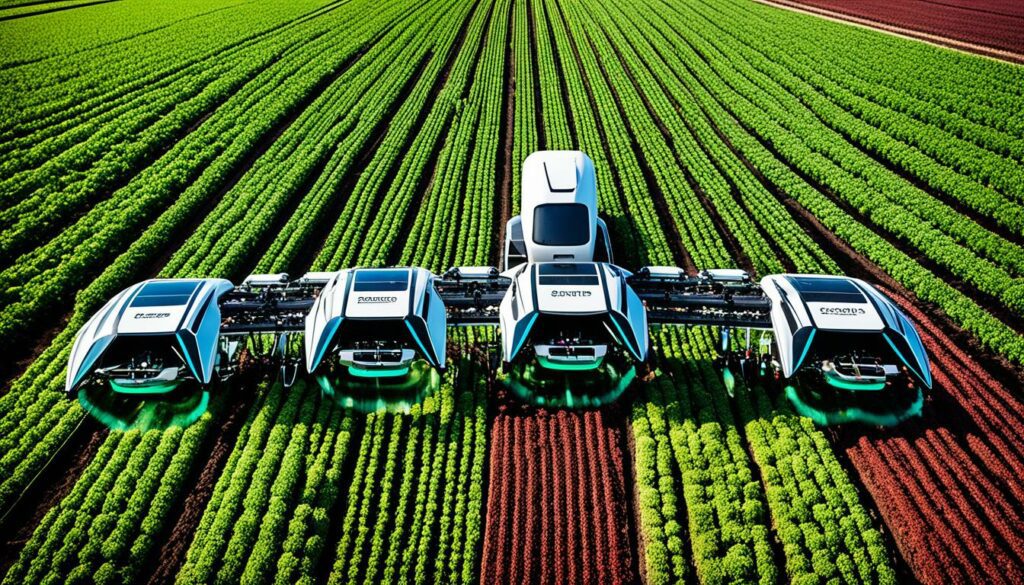
In the 1990s, farmers started marking soil with handheld devices. Now, they use things like satellites and big data to get even better. Companies like John Deere are leading this change by using smart technology and data to help farmers.
AGCO’s Precision Planting is known for its top-notch products improving planting accuracy. These new tools help farmers put water and fertiliser exactly where they’re needed. This is key for getting crops to grow well and produce a lot.
Companies like Agmatix are using data to help farmers grow better crops in a smarter way. Their work aims to increase crop yields while keeping farming sustainable. As technology in farming grows, more teamwork between big tech names, scientists, and farmers is making exciting new opportunities.
Explore the future of farming through precision agriculture and see how new tech is changing farming. These methods help farmers work more efficiently, saving money and the environment.
| Precision Planting Benefits | Technologies Used |
|---|---|
| Uniform Germination | Soil and Crop Sensors |
| Optimal Growth Conditions | Geographic Information Systems |
| High Yield Potential | Automated Machinery |
| Better Resource Utilisation | Big Data Analytics |
Today, digital agriculture is making big changes in farming. It uses data to find better ways for farmers to work. By bringing together lots of real-time information, it makes farms more efficient.
Technology and data are changing how farming works. For example, farmers now use data from the land and crops to make smarter choices. Companies like John Deere use advanced technology to help with these decisions.
There are also startups, such as Agmatix, that are using data to make farming more efficient and better for the planet. By looking closely at what the land needs, they help farmers grow more and better crops without harming the environment.
Farmers can now get live updates on their crops, thanks to new tools like satellite maps. This helps them decide when to plant, water, or harvest. Such real-time information is a game-changer.
AGCO’s Precision Planting is a great example of how tech and farming can work together. It makes planting more efficient. It also uses special predictions to help farmers plan ahead better.
Lastly, using big data and machine learning, farmers get even smarter tips for growing crops. This approach doesn’t just solve current farming problems. It also helps make farms more sustainable and profitable in the long run.
Precision agriculture is a growing area with lots of new tech. It aims to boost crop yields and protect the environment. The leaders here have shown big progress.
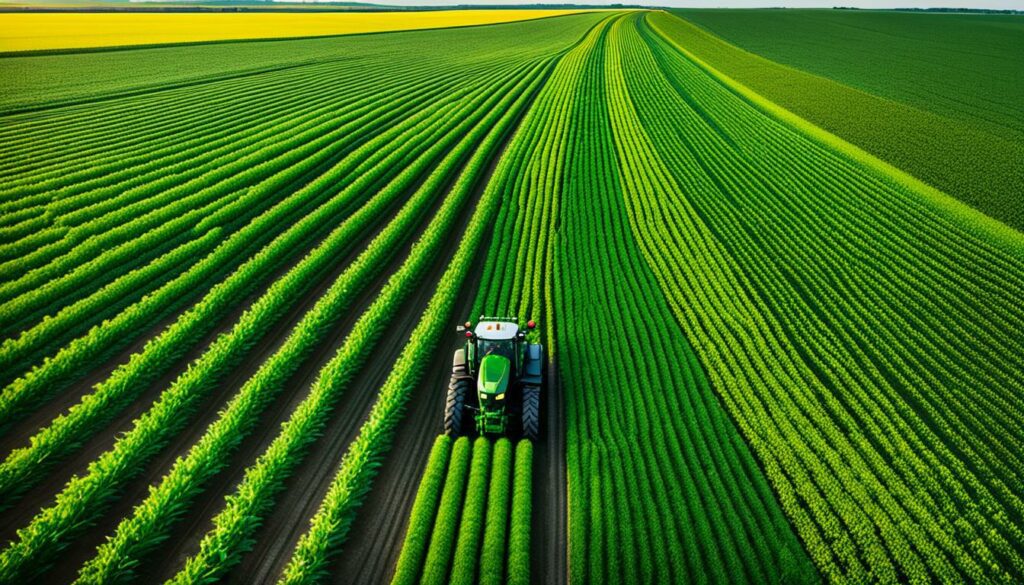
John Deere is known for its high-tech farm solutions. They use data and IoT tech to make farming smarter. In Georgia, USA, they boosted cotton harvests by 8%. They also cut down on water use by 15%. This shows how tech can help both farming output and save resources.
Agmatix, part of ICL Group, focuses on smarter farming through digital tools. They use data closely to predict sugarcane harvests better in India. This has improved both the harvest size and quality by 20%. These advances support farm productivity while caring for the planet.
AGCO’s Precision Planting enhances how seeds are placed for better crops. Their tech boosts maize growth in Kenya by 30%. They do this by monitoring soil through a phone app. AGCO’s work shows the power of merging technology with farming to improve outcomes.
The future of precision agriculture will change farming a lot. It will use AI and IoT to work better and use data more. This approach started in the 1990s with simple devices for soil and land mapping. Now, it uses high-tech drones, AI, and IoT systems.
Companies like John Deere are leading in this area. They have shifted to focus more on technology. With Data analysis, IoT, and machine learning, farmers can make smarter choices. Precision Planting by AGCO also has new products that are changing planting.
Satellite images and sensors give farmers real-time views of their crops. They can check on things like soil health and moisture instantly. This helps them take better care of their fields.
GIS is key in understanding farm landscapes better. It shows farmers detailed maps of their land. Also, machines that can work on their own help cut down on mistakes and save resources.
Using big data helps in agriculture too. It gives deep insights from large data sets. This helps farmers guess future trends and get more crops out of their fields.
Precision agriculture needs teamwork from many areas. Tech firms, researchers, farm experts and farmers must all work together. This way, we can make farming better for the future, using less chemicals and water but getting more crops.
Examples like Solinftec show how well this can work. Their tech has cut down on herbicide use by 97% on some farms. In Indiana, they plan to make 800 units a year, with 10% of their workers being Americans by 2024. This shows how precise farming can be good for the planet and still increase how much we grow.
The use of smart farming varies a lot by location. North America and Europe are ahead in using these technologies. This is because they have better technology and support from their governments. In 2022, the precision agriculture market was worth USD 9.4 billion. It’s expected to grow at 12.6% each year until 2030. GPS, sensors, drones, AI, and robots are making a big change in how farming is done.
In contrast, developing countries are now adopting these technologies too. This is helped by more people knowing about them and the costs dropping. Smart farming is becoming more popular all over the world. It’s common in big crops like corn, soybeans, and wheat. But now, even smaller crops like fruits and vegetables are seeing more use of these technologies.
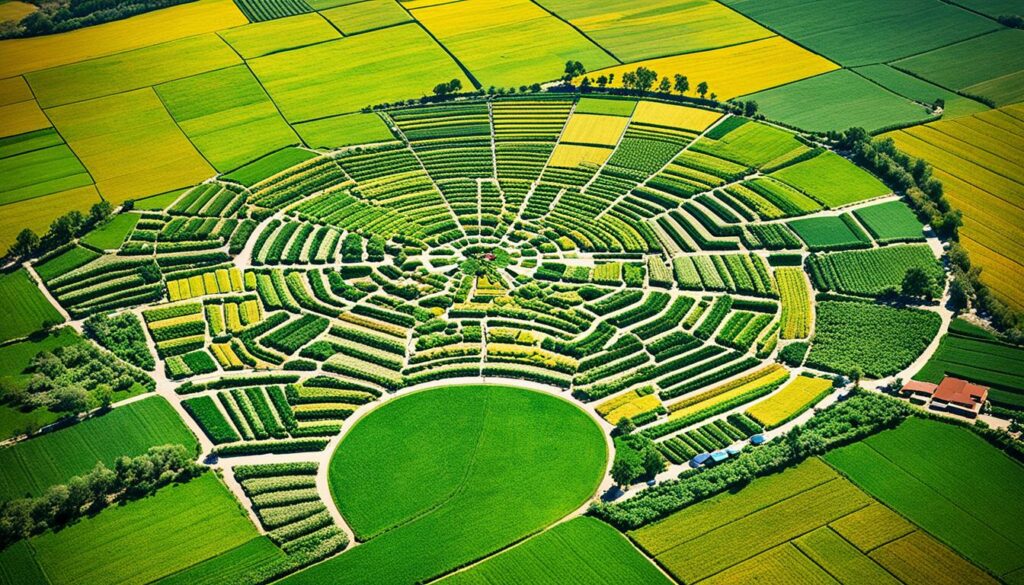
| Region | Adoption Rate | Common Crops | Challenges |
|---|---|---|---|
| North America | High | Corn, Soybeans, Wheat | High Implementation Costs |
| Europe | High | Wheat, Barley, Rapeseed | Technological Complexity |
| Developing Countries | Growing | Fruits, Vegetables | Data Management Issues |
Precision agriculture helps farmers manage their crops better. They can see how their crops are doing in real-time. This lets them adjust their farming to avoid losses quickly. The future of farming is tied to more AI and the Internet of Things, more use of machines that work on their own, and farming that’s better for the planet. Developed countries are using these tools more because they have the right set up for them. But developing areas are catching up, thanks to more access and lower costs.
Big data analytics is key in precision farming. It provides vital insights into weather, soil, and crops. This method helps farmers predict trends and solve problems before they occur.
Predictive modelling uses big data to predict farm outcomes. It helps make farming decisions better. Neural networks predict harvest times accurately, especially for forage legumes. An article on this in the Journal of Big Data got 4111 reads and five citations.
Testing has shown neural networks to work well. They’re effective in dealing with complex farming data in real-time. This proves they’re strong tools for farming.
Data-driven farming is a new way to boost crop growth and support the environment. It aims to achieve the Zero Hunger Goal by 2030. This includes doubling farming’s productivity and making food systems sustainable.
Using soil and crop sensors leads to smarter farming choices. This includes using water and fertiliser more precisely. It helps cut waste and misuse of chemicals. Such an approach could save up to $164 billion per year globally by making food production more efficient.
Big data helps improve many farming aspects. From smart irrigation that adjusts water based on soil data to monitoring crop health in real-time. This leads to precise and efficient farming, supporting both the planet and food production.
Agriculture subsidies and financial incentives are key in boosting the use of precision farming. They help overcome the challenges like high costs. This way, even small farmers can access and benefit from advanced technology.
Financial aid, simple tech solutions, and teamwork are crucial for getting more farms to use precision agriculture. With help from the government, farmers can easily add tools like GPS, sensors, drones, AI, and robots to their work. This leads to better farming, helps the environment, and supports sustainable farming.
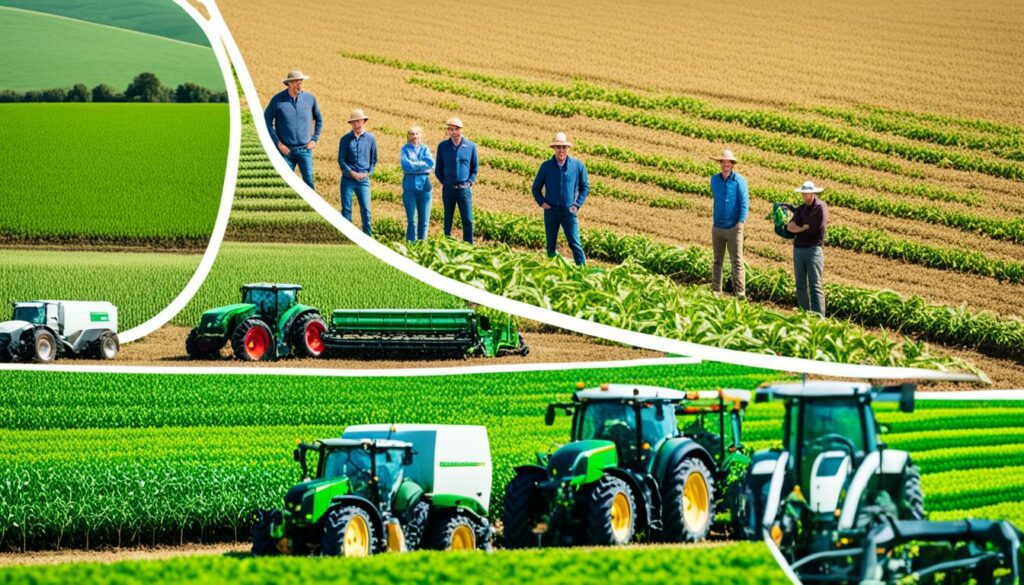
In 2022, the precision market reached $9.4 billion. It’s expected to grow by 12.6% yearly until 2030. Places like North America and Europe are already using these tools a lot because of good support. Now, crops like fruits and vegetables are also starting to benefit.
Thanks to strong data management and tech progress, precision farming is more practical than ever. Farmers can gather and use lots of data to improve how they farm. This is supported by fund and guidance from groups like NIFA, helping agriculture and communities to grow.
| Region | Market Value in 2022 (USD billion) | Predicted Compound Annual Growth Rate (2023-2030) |
|---|---|---|
| North America | 4.1 | 13.0% |
| Europe | 2.8 | 12.4% |
| Asia-Pacific | 1.5 | 11.5% |
| Rest of the World | 1.0 | 11.8% |
Subsidies and support are pushing smart farming forward globally. They’re turning farming into an advanced and greener sector. This change is making agriculture more efficient and better for the planet.
The field of precision agriculture is growing fast, making learning about it more important than ever. By 2030, this sector is set to grow significantly. It is crucial to arm our farmers with the skills and knowledge they need.
Hands-on events like workshops and seminars are great for learning about agricultural technology. At these gatherings, farmers meet experts and share real experiences. They discuss GPS, sensors, AI, and robotics in farming. This sharing of ideas is key for the future of sustainable agriculture.
Workshops and seminars provide invaluable hands-on experience with the latest agricultural technologies, ensuring farmers can practically apply what they learn.
Digital learning platforms bring precision farming education to your fingertips. Farmers can take part in tutorials, webinars, and modules no matter where they are. These courses cover topics like how to use soil and crop sensors and data analysis. This mode of learning is perfect for those who find it hard to attend in-person.
Don’t forget about virtual and augmented reality. They’re making waves in teaching farmers. With AR and VR, farmers can practice in simulations. This tech helps them learn by doing in a safe space.
| Training Program | Duration | Cost | Location |
|---|---|---|---|
| Agriculture Equipment Service Technician | 34 credit hours | $3,061 | Indiana |
| Precision Agriculture Specialist | 34 credit hours | $3,081 | Indiana |
| Precision Agriculture Technician | 34 credit hours | $3,099 | Indiana |
| Precision Agriculture Chemical Applicator | 18 credit hours | $3,061 | Indiana |
Working together helps make precision farming education better. When schools and farming industry leaders like John Deere join forces, everyone wins. They ensure what is taught meets the industry’s needs and uses the latest tech.
Good education in precision farming makes a big difference. It helps farmers around the world work smarter and more sustainably. This is good news for farming and the planet.
The gains from precision agriculture are vast, boosting output and cutting costs efficiently. Thanks to new tech, there’s a 4% bump in crop production, highlighting the shift to intelligent farming methods. This focus lets farmers better place fertilisers, upping efficiency by 7% and making crops better.
Smart farming has a crucial green effect. It cuts herbicides and pesticides by 9%, with 30 million fewer pounds used each year. Also, there’s a 6% drop in using fossil fuels, saving 100 million gallons and curbing global warming gases.
Smart farming is also great for water, using 4% less. This saving equals water for 750,000 Olympic pools. It stops us needing 2 million more acres of land for farming, benefiting our planet.
Below is a deep look into some core impacts:
| Key Metrics | Current Impact | Potential Impact with Full Adoption | t
|---|---|---|
| Crop Production Increase | 4% | N/A | t
| Fertilizer Placement Efficiency Increase | 7% | 14% | t
| Reduction in Herbicide/Pesticide Use | 9% | 48 million pounds avoided | t
| Reduction in Fossil Fuel Use | 6% | 16% | t
| Reduction in Water Use | 4% | 21% | t
| CO2 Emissions Avoided | 10.1 million metric tons | 17.3 million metric tons | t
Examining both the economic and green merits of precision agriculture shows its key role in modern, efficient, and environment-friendly farming practices.
Precision agriculture is making farming smarter and more sustainable. It brings together the latest technology and deep data analysis. This leads to farming that is efficient, saves money, and is kind to the environment.
This movement started in the 1990s with simple devices to map soil. It has now grown into a tech revolution for agriculture. Companies like John Deere and Agmatix are leading this change.
AGCO’s Precision Planting is also pushing the boundaries with its mix of old farming knowledge and new tech. They use satellites, sensors, and big data to farm better. This wave of progress involves AI and machine learning, promising a positive future for farming.
The future of farming thanks to precision agriculture looks bright. It will bring better efficiency, a greener approach to farming, and more food for everyone. This path is essential to care for the planet, lessen our impact, and keep farming strong around the globe.
Precision agriculture is about using tech to understand the variety in fields. It aims to measure this variation, making farming more efficient and sustainable. Technologies like IT, equipment, and software are used. They provide insights into the soil, crops, and the environment. This helps farmers apply resources precisely. This approach boosts sustainability and productivity.
Precision agriculture trends include the increasing use of AI and IoT. These push farming beyond traditional methods. They help farmers be more accurate and efficient. Sustainability practices, like capturing carbon, are also growing. Farming autonomously and using data for predictions are also key future directions.
It boosts crop yields by managing nutrients and planting more accurately. Farmers use detailed soil and crop data to create the best conditions. This means each plant gets the exact nutrients it needs. This thorough approach leads to better and more crops.
The high cost of technology and equipment is a barrier. Managing the huge amount of data also poses a challenge. For some farmers, the complexity of the systems can be overwhelming. They may lack the technical skills or resources to handle it.
New tech includes using satellites to monitor fields and sensors to track soil and crops. Machinery that can work on its own, like self-driving tractors, is also evolving. These technologies improve farming by making it more accurate and efficient.
AI is changing farming by predicting weather and diseases. It helps farmers take early steps to protect their crops. AI also makes tasks, like weed detection, easier, and more efficient. This results in better farm productivity with less human work.
IoT links farming tools, allowing for quick problem-solving. This connection helps with managing resources better and making smarter decisions. It is a key player in improving farming efficiency with timely data.
Precision agriculture encourages techniques that save water and reduce carbon. By using less water and capturing carbon, farming becomes more environmentally friendly. These methods not only help the planet but also increase farm production and strength.
These entail planting seeds accurately, promoting even growth. Knowing the best seed depth and spacing is vital. It helps crops start well and gives them the right start for a good harvest.
Companies like John Deere are changing farming with smart analytics and IoT. They help farmers make better choices based on data. Others, like Agmatix and Precision Planting, also use technology for better farming. They improve efficiency and care for the land.
Precision agriculture’s spread changes from place to place. Advanced areas like North America lead, using more tech and support. But, developing places are catching up, thanks to lower tech costs and awareness. The impact depends on the crops and needs of each region.
Precision agriculture lowers costs and boosts farm income. It also uses resources more wisely, cuts greenhouse gases, and helps farming last. These actions are vital for the Earth’s health.